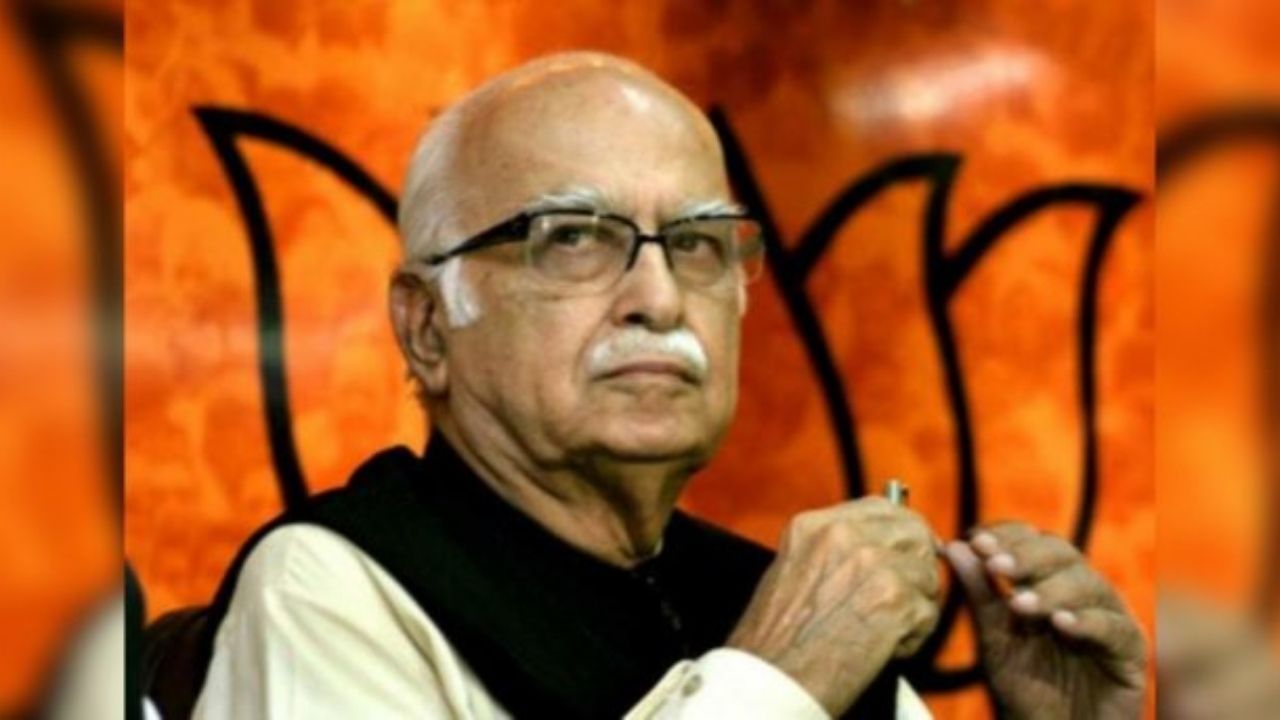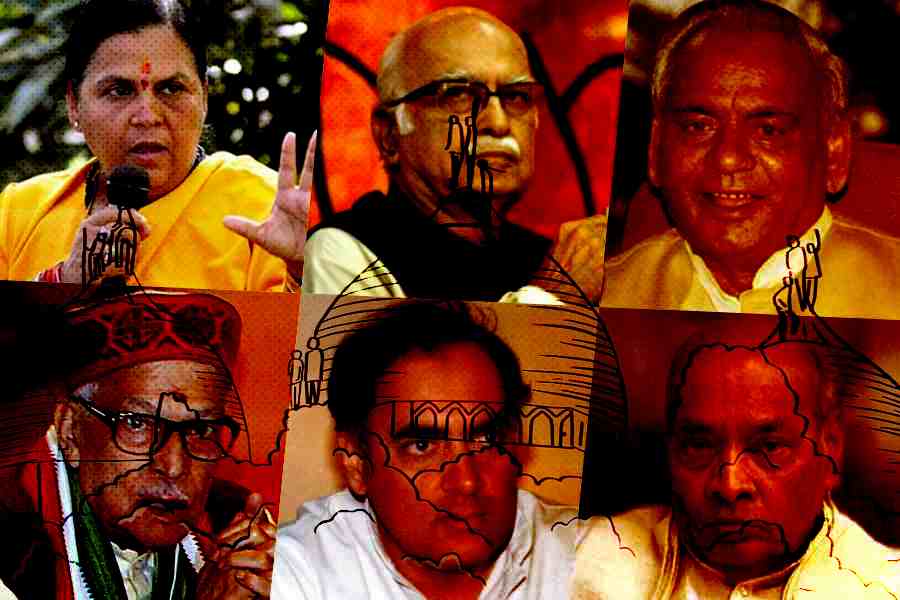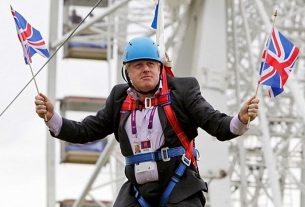Tue 6 December 2022:
New Delhi: The rise of Hindutva and Ram temple politics in the 1980s and 1990s led to the demolition of the Babri Mosque which stood at the spot where the Sangh parivar claimed that the Hindu community believed that Ram was born.
The Wire takes a look at the personalities and the events that led to the demolition of the mosque — a fact which takes on great significance on a day when the title dispute verdict has come from the Supreme Court.
Lal Krishna Advani
When it comes to the demolition of the Babri Masjid and the violence that preceded and followed it – in which the lives of thousands of Indians were lost – former deputy prime minister Lal Krishna Advani’s name comes first.
The Bharatiya Janata Party was founded in 1980 and Advani assumed leadership of the Ram Janmabhoomi movement in 1984 before becoming party president in 1986.
He was the face of and the brain behind the rath yatra of 1990 which stirred support for the demand for the construction of a Ram temple at the very spot where the Babri mosque had stood since 1527.

The yatra left to large scale violence and rioting along its path. During the yatra ,Advani made it abundantly clear that he was not carrying a message of peace. Pictures of him carrying a trishul, an axe, a sword and a bow and arrow also emerged.
Two years later on December 6, 1992, Advani was on the dais 200 metres from where the mosque stood provoking the kar sevaks who went on to demolish the mosque.
A police officer who had accompanied Advani that day told a CBI court, “On December 6, 1992 Advani made a spirited speech from Ram Katha Kunj Manch, barely 150-200 metres from the disputed site, which charged the people. He repeatedly said that the temple would be constructed at the same site.”
According to the CBI chargesheet, Advani was also present at a secret meeting on December 5, 1992, at Vinay Katiyar’s home where the final decision to demolish the mosque was taken.
He has been named by the CBI as a conspirator in the criminal case of the demolition of Babri masjid. The final verdict is awaited.
Rajiv Gandhi
If responsibility is to be apportioned for preparing the ground and providing fuel for the rise of the Ram Janmabhoomi movement, Rajiv Gandhi assumes key role. Between 1949 – when idols of Lord Ram were surreptitiously placed inside the Babri Masjid – and 1986, the Ayodhya dispute had been a relatively low intensity one. Until then, the premises of the masjid had been locked and a priest was allowed to perform a ritual puja for the idols only once a year.
It was Gandhi’s decision – aided by his prime strategist Arun Nehru – on February 1, 1986, to open the locks of the Babri masjid that provided the wind in the sails of the Sangh parivar’s movement to ‘break free’ the idols of Ram.
This opened up the Babri masjid for the Hindu community and more importantly the Sangh parivar whose cultural, ideological and political agenda was to take control of the ‘birthplace’ of Ram

Former Prime Minister Rajiv Gandhi. Photo: INC
While technically it was district judge Krishna Mohan Pandey who ordered that the gates of the masjid be opened and Hindus be allowed to worship, it has been widely reported that the direction came from the top – from Prime Minister Rajiv Gandhi.
Historian Ramachandra Guha wrote, “the judge’s order was widely believed to have been directed from Delhi, from the Prime Minister’s Office, no less. The local administration seemed to know of the judgment beforehand, for the locks were opened within an hour of the verdict.”
The move sent a message that the Indian state favoured the Hindu claim over the land where the Babri Masjid stood and which the Sangh parivar claimed was the birthplace of Ram.
In 1989, the Rajiv Gandhi government also failed to prevent the shilanyas (laying of the foundation stone of the Ram temple) and shila pujan (worship of the idols) inside the premises of the Babri Masjid.
Within six years of the opening of the locks of the Babri Masjid by the Rajiv Gandhi government, the structure was demolished by kar sevaks led by BJP leaders including L.K. Advani and Murli Manohar Joshi as the state machinery stood, watched, aided and abetted.
Kalyan Singh
As chief minister of Uttar Pradesh at the time the Babri masjid was demolished, Kalyan Singh was responsible for maintaining law and order in Ayodhya and the protection of the Babri masjid as 1,50,000 kar sevaks led by BJP leaders gathered around it.
But, the role he played was in stark contrast with his responsibilities and duties.
According to the CBI chargesheet in the demolition of the Babri mosque case, Kalyan Singh had in 1991 said, that during his tenure “a temple of Shri Ram will inevitably be constructed.”

Former UP chief minister and Rajasthan governor Kalyan Singh. Photo: PTI
Also according to the chargesheet, a few days prior to December 6, 1992, Singh had said, “Rok construction per lagi hai, destruction par nahi (‘the stay is on construction, not on destruction’).”
Singh was also responsible for acquiring the 2.77 acres of disputed land in Ayodhya under the pretext of developing it for tourism purposes. This cleared the land around the Babri Masjid, paving the way for lakhs to gather around the mosque.
The CBI chargesheet squarely blamed Singh not only for being unable to protect the mosque but also for being an active participant in the conspiracy to demolish it. “It is further evident from the investigation that Kalyan Singh, in order to achieve the objectives of the criminal conspiracy as aforesaid not only failed to live up to its promises to protect the disputed structure but continued to aid and abet the criminal conspiracy to ensure its destruction,” the chargesheet said.
It also noted that despite the availability of central paramilitary forces who were well equipped with riot gear and rubber bullets to be able to deal with the mobilisation in Ayodhya on December 6, Singh doggedly refused to deploy the force.
Perhaps, accepting complicity Singh said in March 1993, “Vivadith dhanche ki suraksha na kar pane ka unhe koye afsos nahi hai, kyonki ve 464 saal purana gulami ka chinh tha (‘They don’t regret not being able to protect the controversial structure because it was a 464-year-old symbol of slavery’).”
Vinay Katiyar
Katiyar was the sitting member of parliament from the Faizabad Lok Sabha constituency – where Ayodhya is located – when the Babri mosque was demolished.
According to the CBI chargesheet in the criminal case of the demolition of the Babri mosque, a key meeting on December 5, 1992 – one day before the mosque was brought down – was held at Katiyar’s home.
In this ‘secret meeting’ which was attended by LK Advani, Pawan Pandey, etc, the final decision to demolish the mosque was taken.

File photo of Vinay Katiyar. Photo: PTI
The next day Katiyar was present on the dais about 150-200 metres from the mosque where leaders of the BJP including L.K. Advani, Murli Manohar Joshi and Uma Bharti made provocative speeches.
A.G. Noorani wrote in his book, Babri Masjid – A National Dishonour, that one of the first FIRs filed after the mosque was demolished mentioned Katiyar as one of the eight people who delivered communally inflammatory speeches prior to the demolition.
Today, after the Supreme Court judgment came, Katiyar made an appeal for peace and harmony.
Murli Manohar Joshi
According to the CBI chargesheet, Joshi played a key role in stirring up sentiment for the building of a Ram temple and demolition of the Babri mosque. Joshi too is mentioned as a conspirator by the CBI.
The chargesheet noted, “According to the investigation, Murli Manohar Joshi had said at Mathura on December 1, 1992, on his way to Ayodhya that no force can stop construction of Ram temple and he was encouraging the kar sevaks from the manch on December 6, 1992, for the demolition of the disputed structure and was shouting provocative slogans.”

File photo of Narendra Modi and Murli Manohar Joshi. Photo: PTI
The charge sheet also notes that on December 6, 1992 the leaders gathered at the dais close to the Babri mosque were provoking the kar sevaks using slogans like, “Ek dhakka aur do, Babri Masjid tod do” (‘Give one more push and demolish the Babri mosque’).
Uma Bharti
Bharti was another BJP leader who was present at the dais next to the mosque prior to the demolition.
She has been indicted both by the Liberhan commission and the CBI for her role in provoking the kar sevaks gathered at the site of the mosque on December 6, 1992.
According to the chargesheet, some of the slogans that Bharti used were, “Masjid girao, mandir banao, Babar ki aulad ko Pakistan bhagao” (‘Demolish the mosque, construct the temple, sends Babar’s progeny to Pakistan’).

File photo of Uma Bharti. Photo: PTI/Subhav Shukla
Also, according to the chargesheet, as the kar sevaks were demolishing the mosque, Bharti shouted, “Utho jawano, ek dhakka aur do, Babri Masjid tod do,” implying that she was urging the kar sevaks to get on with the job of demolishing the mosque.
P.V. Narasimha Rao
Rao, who famously remarked that ‘not taking a decision is a decision’ was Prime Minister of India when the Babri Masjid was demolished. His indecisiveness in the period leading up to the demolition proved decisive in the end.
Several months prior to the demolition, the Union home ministry had planned to take over the mosque to prevent any untoward incident from occurring. It waited for the go-ahead from Rao to arrive. That never did.

He has also been criticised for the decision to not dismiss the BJP-led Uttar Pradesh government which had been accused of acting in a partisan manner and whose political agenda it was to build a temple at the spot where the Babri Masjid stood.
Rao defended himself by saying that Kalyan Singh, the chief minister of Uttar Pradesh, assured him that the mosque will not be harmed. This assurance, Rao claimed, he took at face value.
In an interview to Indian Express, Rao said, “Mere dismissal does not mean you can take control. It takes a day or so appointing advisers, sending them to Lucknow, taking control of the state. Meanwhile, what had to happen would have happened and there would have been no Kalyan Singh to blame either.”
Atal Bihari Vajpayee
Vajpayee was largely known for his relatively moderate and liberal stand on issues that tend to invoke great passion among the Sangh parivar. But, Ayodhya was one of the issues where Vajpayee’s proverbial mask came off.
A day prior to the planned kar seva which led to the demolition of the mosque, Vajpayee gave a speech in Lucknow where he said, “Ab bhajan, kirtan karne ke liye baithna padega aur nukilee patthar par to koi baith nahi sakta, zameen ko samtal karna padega.” (‘In order to offer prayers, one will have to sit. One cannot sit on sharp and pointed stones. The ground will have to be levelled’).

Atal Bihari Vajpayee. Photo: PTI/Files
The Liberhan commission report found Vajpayee culpable in the conspiracy to demolish the Babri mosque. “It cannot be assumed even for a moment that L.K. Advani, A.B. Vajpayee or M.M. Joshi did not know the designs of the Sangh Parivar. Even though these leaders were deemed and used by the Parivar to reassure the cautious masses, they were [in fact] party to the decisions which had been taken,” it said.
VHP president Ashok Singhal
Singhal was one of the key movers and shakers behind the Ram Janmbhoomi movement and assumes particular importance as the Vishwa Hindu Parishad was fighting the legal battle of the Ayodhya title dispute on ‘behalf’ of Ram lalla virajman – the deity who being a ‘perpetual’ minor needed a shebait (or manager, who serves the deity).
He was among the first voices to demand that the gates of the Babri Masjid be opened in 1984 and launched the Ram Janaki Rath Yatra, which was the first large scale movement for the Hindu claim on the disputed land.

File photo from 2010 of the late VHP president Ashok Singhal with Narendra Modi. Photo: PTI
Since then, he played a key role in liasons with the Sangh parivar, in making plans, chalking strategies and shaping the Ram Janmbhoomi movement.
According to the Liberhan commission report, the laying of the foundation stone of the Ram temple – aided by the inaction of Rajiv Gandhi – at the site of the mosque was carried out under the leadership of Singhal.
Singhal was also present at the site of the Babri masjid on December 6 and was one of the speakers. He has also been mentioned by the CBI as one of the conspirators.
BJP leader Subramaniam Swamy has now demanded that the government ‘must immediately’ bestow Singhal the Bharat Ratna.
Arun Nehru and Vir Bahadur Singh
It was the Congress’s triumvirate of Rajiv Gandhi, Arun Nehru and Vir Bahadur Singh that played a key role in the opening of the gates of the Babri mosque in 1986.
Arun Nehru was Rajiv Gandhi’s cousin and had the prime minister’s ear in the crucial period leading up to the moment when the decision to open the gates for Hindu prayer was taken. Vir Bahadur Singh was the chief minister of Uttar Pradesh between 1985 and 1988.
The decision to open the gates was taken by Gandhi advised by Nehru with a view to try to and take advantage of the public sentiment that had begun to grow since the 1984 yatra of the VHP.
The Faizabad district court announced that the gates of the Babri masjid be opened and the administration, as if on cue, was on hand to execute the order within an hour. Television cameras were also present to record and broadcast the triumphant entry of Hindu worshippers into the Babri mosque precinct.
The organisation of the arrangement that were made for the opening of the gates and the entry of worshippers was organised by Arun Nehru and Vir Bahadur Singh.
But both the Liberhan commission and the CBI chargesheet excluded Gandhi, Nehru and Singh from indictments.
By: Kabir Agarwal
-The Wire
___________________________________________________________________________________________________________________________________
FOLLOW INDEPENDENT PRESS:
TWITTER (CLICK HERE)
https://twitter.com/IpIndependent
FACEBOOK (CLICK HERE)
https://web.facebook.com/ipindependent
Think your friends would be interested? Share this story!






